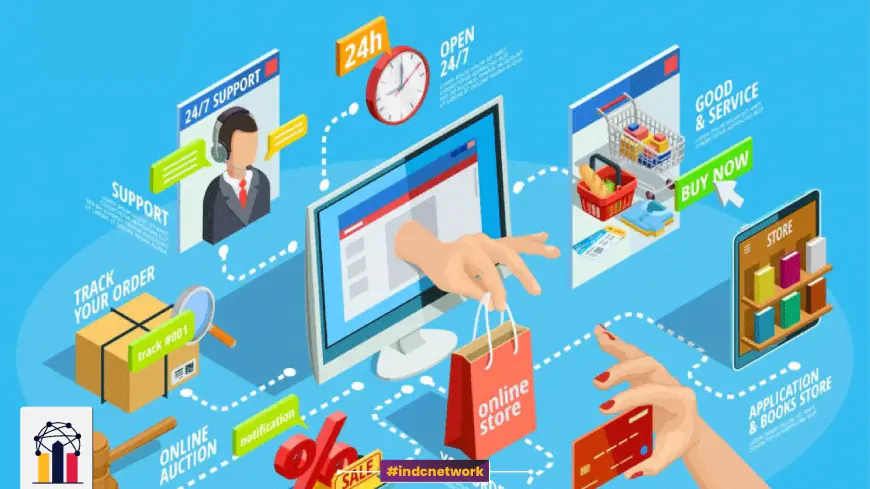Unveiling the Surprising Forces Driving E-Commerce Growth: A Deep Dive Into Future Trends
E-commerce has transformed the global retail landscape, experiencing explosive growth over the past decade. This in-depth article explores the key factors fueling e-commerce's rise, from technological advancements to shifting consumer behaviors. It delves into future trends, such as AI, personalization, and omnichannel strategies, that will continue to shape the future of online shopping. Discover how e-commerce is reshaping the way businesses operate and what lies ahead for the industry.

INDC Network : Business : Unveiling the Surprising Forces Driving E-Commerce Growth: A Deep Dive Into Future Trends
Over the past two decades, e-commerce has revolutionized how consumers shop and businesses operate, transforming the global retail landscape. What began as a niche segment of the retail market has evolved into a multi-trillion-dollar industry, touching nearly every corner of the world. From the convenience of online shopping to the rise of mobile commerce and personalized experiences, e-commerce has become a key driver of the digital economy.
But what forces are truly driving the phenomenal growth of e-commerce, and what lies ahead in this rapidly evolving space? This article explores the hidden dynamics behind the surge in e-commerce, the transformative technologies propelling the sector, and the future trends that will shape the online shopping experience.
The Explosive Rise of E-Commerce: A Snapshot of Growth
E-Commerce by the Numbers : E-commerce has experienced exponential growth over the last decade, with global e-commerce sales surpassing $5 trillion in 2021. This figure is expected to double by 2026, with regions such as North America, Europe, and Asia-Pacific leading the charge. In 2023, it was estimated that over 20% of all retail sales occurred online, with China and the United States being the largest e-commerce markets in the world.
Several factors have contributed to this rapid expansion, including increased internet penetration, the proliferation of smartphones, and the convenience of online shopping platforms. The COVID-19 pandemic further accelerated this growth, as lockdowns and social distancing measures forced consumers to turn to e-commerce for everything from groceries to luxury goods.
The Pandemic Effect : The COVID-19 pandemic created an unprecedented surge in e-commerce activity. With physical stores shuttered or operating under restrictions, consumers flocked to online platforms. The pandemic served as a catalyst, pushing businesses to rapidly adopt e-commerce strategies and expand their digital presence.
Sectors like grocery delivery, health and wellness, and home goods experienced particularly strong growth during the pandemic. Companies that were previously slow to embrace e-commerce—especially small businesses—found themselves pivoting quickly to survive. This period of digital acceleration reshaped not only consumer expectations but also how companies approached digital transformation.
The Key Drivers of E-Commerce Growth
1. Technological Advancements : Technology is at the core of e-commerce growth. Innovations such as high-speed internet, mobile devices, and secure payment gateways have made online shopping easier and more accessible than ever before.
Key Technologies Fueling Growth:
- Mobile Commerce (M-Commerce): With mobile devices accounting for over 50% of global internet traffic, consumers are increasingly using smartphones and tablets for their shopping needs. Mobile-friendly websites, apps, and one-click checkout options have made mobile commerce a vital component of the e-commerce ecosystem.
- Cloud Computing: The ability to store, manage, and process data in the cloud has enabled e-commerce businesses to scale quickly and efficiently. Cloud-based platforms allow businesses to offer seamless shopping experiences while reducing operational costs.
- Artificial Intelligence (AI) and Machine Learning: AI has revolutionized personalization in e-commerce by analyzing consumer behavior to offer tailored product recommendations and dynamic pricing. Machine learning algorithms also power chatbots, which enhance customer service and streamline support.
2. Shifting Consumer Behavior : The rise of e-commerce is closely tied to changes in consumer behavior. Today’s shoppers are digital-first, seeking convenience, variety, and immediacy in their shopping experiences. Several key shifts have occurred in recent years:
- Convenience and Time Savings: E-commerce offers unparalleled convenience, allowing consumers to shop from the comfort of their homes at any time. The ability to avoid crowded stores, long lines, and limited product availability has driven the migration to online shopping.
- Price Sensitivity and Comparisons: Consumers have more power than ever to compare prices across multiple platforms before making a purchase. E-commerce allows for easy price matching, ensuring that shoppers can find the best deal without physically visiting stores.
- Rise of Subscription Services: Subscription-based e-commerce, offering everything from beauty boxes to meal kits, has grown in popularity. These services provide personalized products delivered on a regular basis, catering to consumers' desire for tailored experiences and convenience.
3. Globalization and Market Expansion : E-commerce has opened the doors to global markets for both businesses and consumers. Platforms such as Amazon, Alibaba, and Shopify have enabled small businesses to sell internationally, while global payment solutions have made cross-border transactions seamless.
Key Trends in Globalization:
- Cross-Border E-Commerce: With the rise of international shipping and localized payment options, cross-border e-commerce has become a significant growth driver. Consumers are no longer limited to products available in their own countries.
- Localization Strategies: To succeed in new markets, e-commerce businesses must tailor their offerings to local languages, currencies, and cultural preferences. Companies that adopt strong localization strategies are better positioned to capture global audiences.
4. Logistics and Fulfillment Innovations : As e-commerce has grown, so too has the demand for efficient logistics and fulfillment services. To meet customer expectations for fast, reliable delivery, businesses have had to innovate their supply chains.
Key Logistics Trends:
- Last-Mile Delivery: The “last mile” of delivery—the final step in getting a product to a customer’s doorstep—has become a major focus for e-commerce companies. Innovations like drone deliveries, autonomous vehicles, and smart lockers are being explored to improve speed and reduce costs.
- Fulfillment Centers and Warehousing: Companies like Amazon have invested heavily in warehousing and fulfillment centers, enabling them to store products closer to consumers for faster delivery. These centers use automation and robotics to streamline operations.
5. Payment Solutions and Fintech Innovation : The ease and security of online payments have significantly contributed to e-commerce growth. Fintech innovations, such as digital wallets, Buy Now Pay Later (BNPL) services, and cryptocurrency, have made it easier for consumers to complete transactions.
Popular Payment Methods:
- Digital Wallets: Services like PayPal, Apple Pay, and Google Pay allow consumers to store payment information securely and check out quickly.
- BNPL: The rise of Buy Now Pay Later services, such as Afterpay and Klarna, has made high-ticket items more accessible to consumers by allowing them to pay in installments.
- Cryptocurrency: Some e-commerce platforms have started accepting cryptocurrencies like Bitcoin as payment, appealing to tech-savvy consumers who prefer decentralized financial systems.
Future Trends Shaping the E-Commerce Industry
As e-commerce continues to evolve, several emerging trends will shape the future of the industry. These trends promise to make online shopping even more personalized, efficient, and engaging.
1. Personalization and AI-Driven Experiences : Personalization will be a critical factor in the future of e-commerce. Consumers increasingly expect tailored experiences, with product recommendations, dynamic pricing, and personalized marketing messages based on their preferences and shopping behavior.
AI in Personalization:
- Product Recommendations: AI algorithms analyze consumer data to recommend products that align with their tastes and past purchases. These systems can increase sales by offering relevant suggestions at the right time.
- Dynamic Pricing: AI can adjust prices in real-time based on factors like demand, inventory levels, and consumer behavior. This allows businesses to optimize pricing strategies for maximum profit.
- Chatbots and Virtual Assistants: AI-powered chatbots are improving customer service by providing instant responses to inquiries and guiding shoppers through their purchase journey.
2. Voice Commerce and Conversational Shopping : Voice-activated shopping is poised to become a major trend as devices like Amazon Echo and Google Home gain popularity. Voice commerce allows consumers to make purchases using voice commands, creating a hands-free, conversational shopping experience.
Voice Commerce Potential:
- Convenience: Voice commerce simplifies the shopping process, allowing users to order products, track deliveries, and reorder frequently purchased items without navigating a website.
- AI Integration: Smart speakers and virtual assistants powered by AI will continue to evolve, offering more sophisticated shopping experiences through voice-activated search and personalized recommendations.
3. The Rise of Social Commerce : Social commerce—shopping directly through social media platforms—has gained significant traction in recent years. Platforms like Instagram, Facebook, and TikTok have integrated e-commerce features that allow users to browse and purchase products without leaving the app.
Key Features:
- Shoppable Posts: Social media posts with embedded product links allow users to purchase items with just a few clicks.
- Influencer Marketing: Social media influencers have become powerful drivers of e-commerce sales, promoting products through sponsored posts and partnerships.
- Live Shopping: Real-time video shopping experiences, where influencers or brands showcase products during live streams, are gaining popularity in markets like China and the U.S.
4. Omnichannel Retail and Seamless Integration : The future of e-commerce will be defined by the integration of online and offline experiences. Omnichannel retail strategies aim to provide consumers with a seamless experience across multiple channels, whether they’re shopping on a website, in-store, or via mobile apps.
Omnichannel Innovations:
- Click-and-Collect: Many retailers now offer the option to buy online and pick up in-store, blending the convenience of e-commerce with the immediacy of in-store shopping.
- Unified Customer Experience: Retailers are investing in systems that allow for consistent customer experiences, such as synchronized loyalty programs, across all channels.
5. Augmented Reality (AR) and Virtual Reality (VR) in E-Commerce : AR and VR are transforming the way consumers interact with products online, allowing them to visualize items in their real-world environments or explore virtual stores.
AR/VR Applications:
- Virtual Try-Ons: Beauty and fashion brands are using AR to allow customers to try on clothes or makeup virtually before making a purchase.
- Interactive Shopping: Virtual reality creates immersive shopping experiences, where users can explore virtual stores, interact with products, and make purchases.
Conclusion: The Future of E-Commerce is Limitless : E-commerce growth shows no signs of slowing down. The forces driving this expansion—technological innovation, changing consumer behavior, and the increasing globalization of online retail—are reshaping the business landscape. As we move into the future, personalization, AI, omnichannel strategies, and new shopping experiences will play pivotal roles in defining how consumers interact with brands and make purchases.
For businesses, the challenge will be to adapt quickly to these trends and continue innovating to meet consumer expectations. The future of e-commerce promises endless possibilities, and those who embrace these changes will thrive in an increasingly digital world.
This article offers a comprehensive look at the factors behind e-commerce growth, the current trends driving its expansion, and a glimpse into the future of online retail. It serves as a roadmap for businesses looking to capitalize on the evolving e-commerce landscape.







